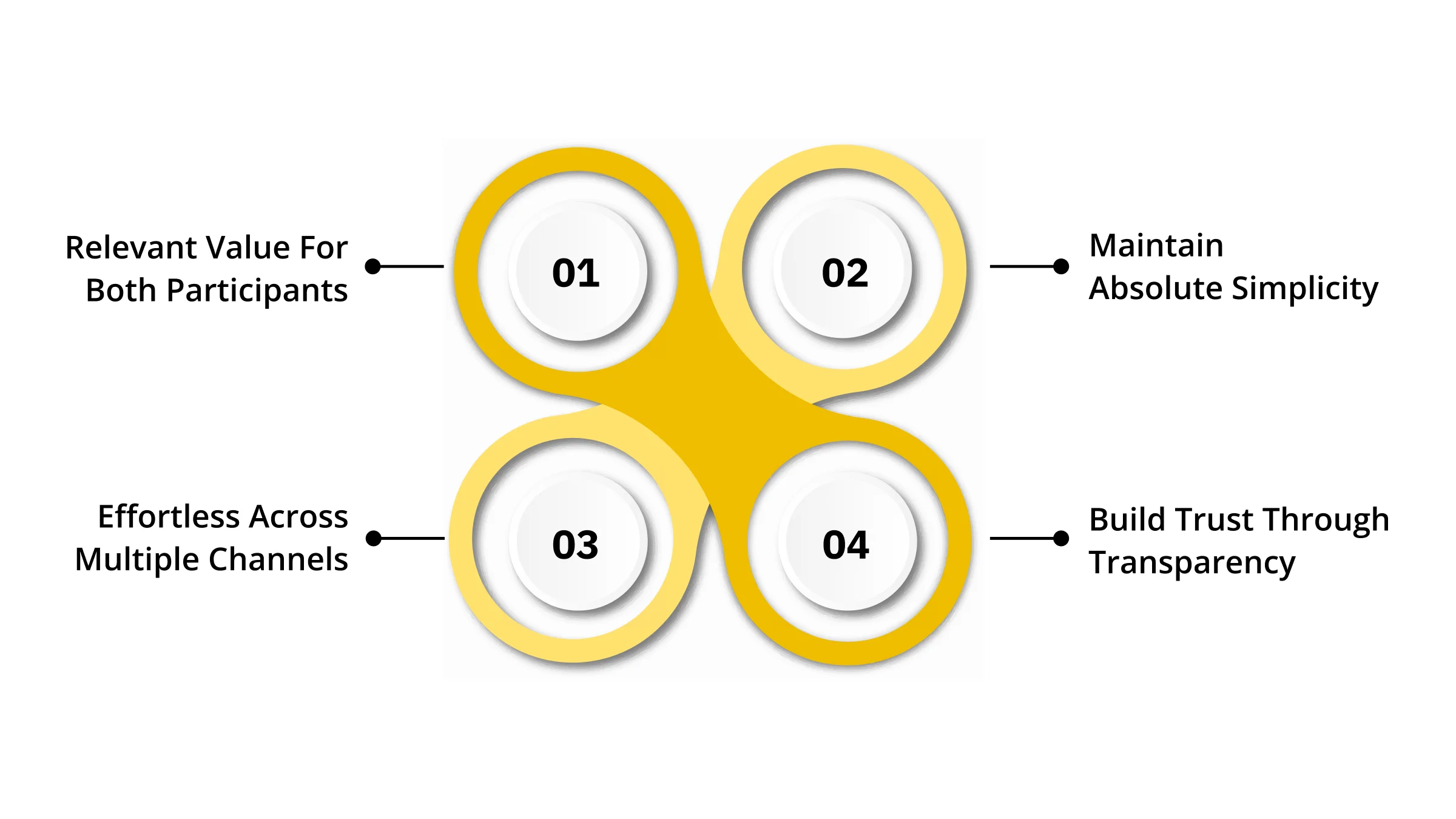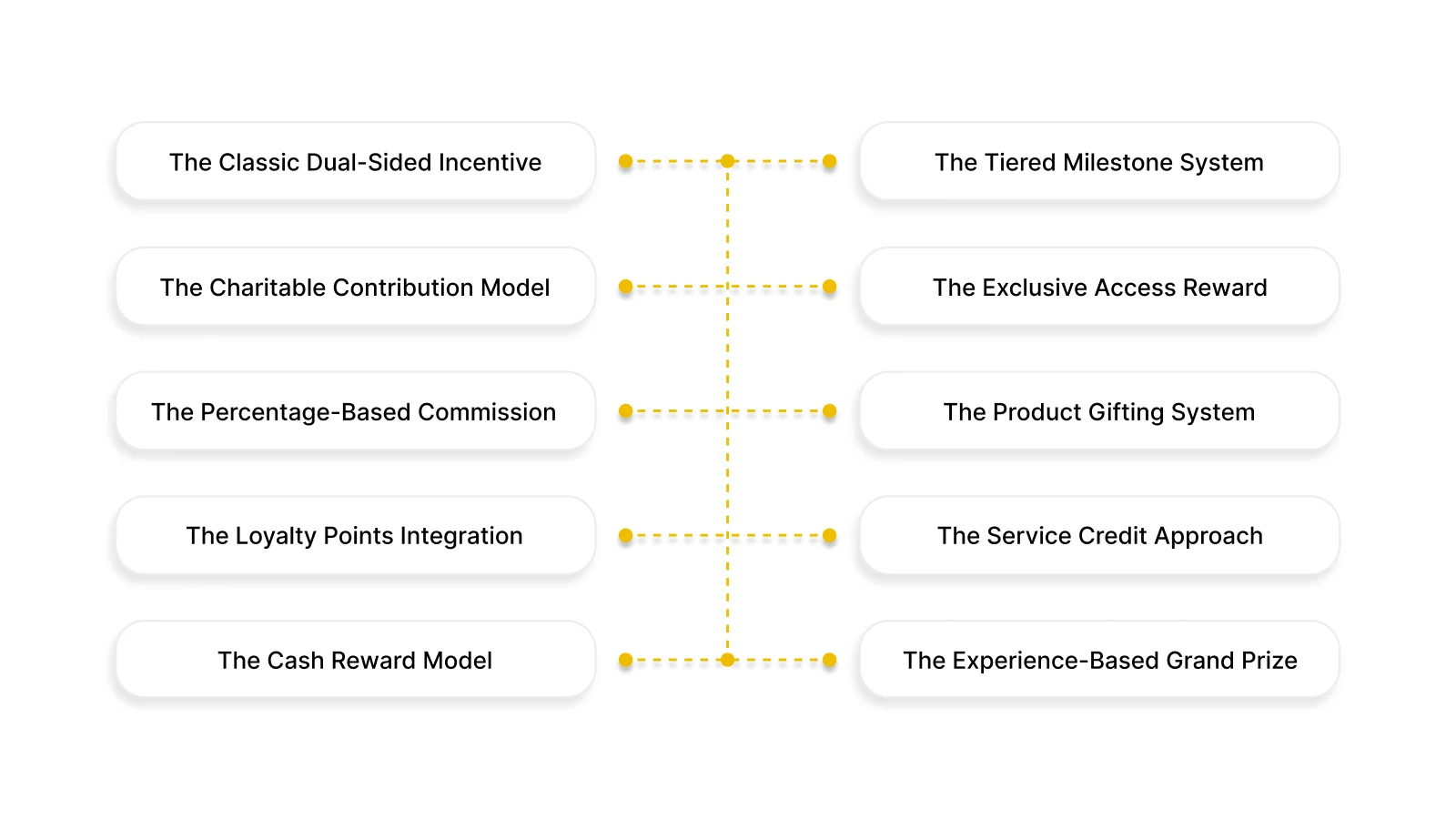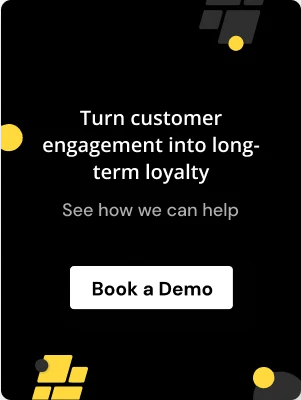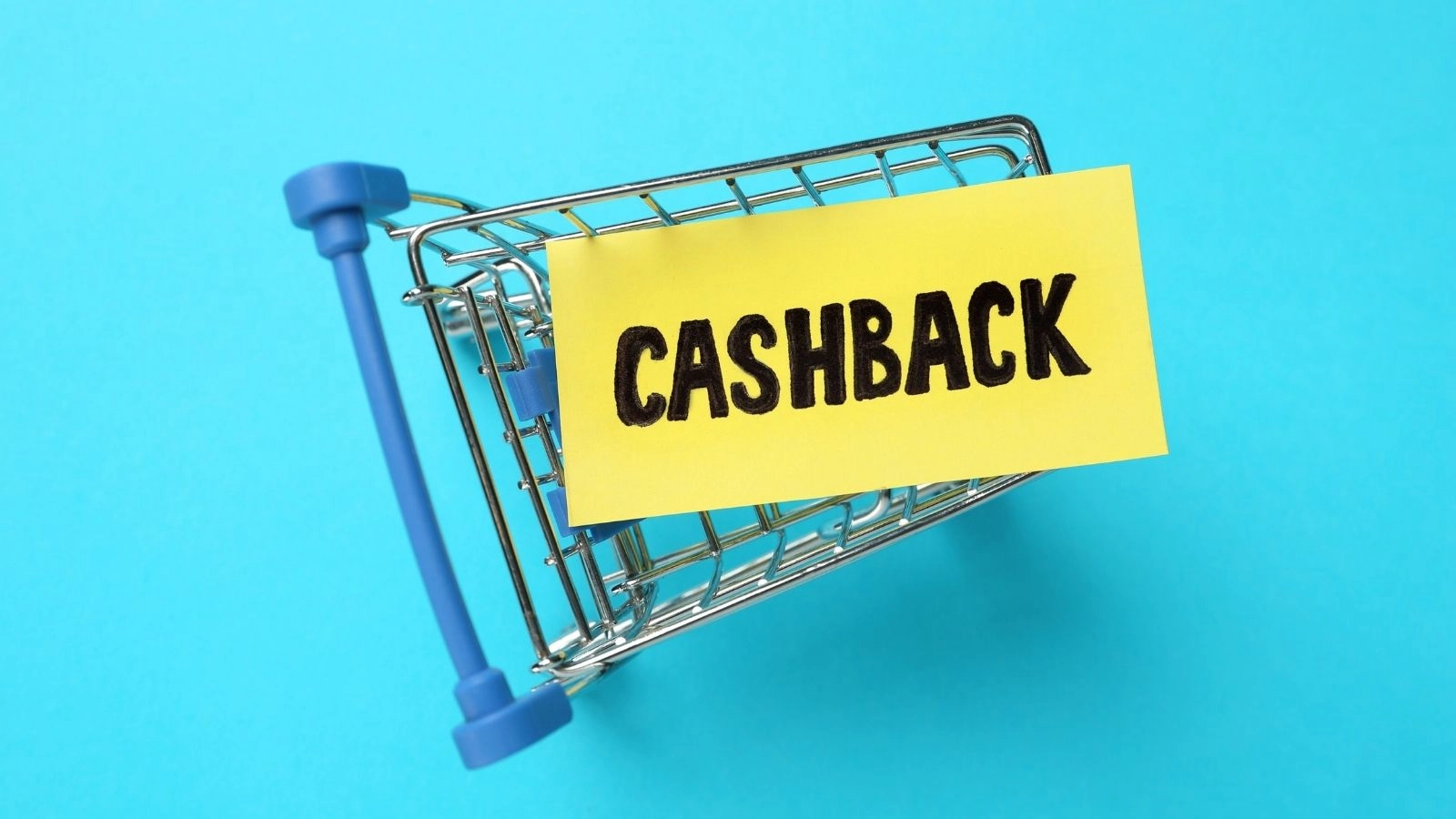.avif)
.avif)
Businesses work hard to deliver an excellent product and customer experience. Yet your growth still depends heavily on expensive advertising channels. This constant spending drains your marketing budget over time.
Strategic referral programs directly address this customer acquisition challenge. They systematically leverage your happiest customers for new qualified leads. In fact, 71% of consumers said that social media referrals easily influence them. These programs build sustainable organic growth through trusted personal recommendations.
This guide will showcase powerful referral examples from top brands. You will learn the exact strategies that make these programs so successful. We will also show you how to implement these tactics effectively.
At A Glance:
- Successful referral programs share four core traits: compelling mutual value, absolute simplicity, effortless sharing, and complete transparency.
- The most effective incentives range from dual-sided rewards to charitable donations, tiered systems, and exclusive access opportunities.
- Implementation requires strategic placement at optimal customer touchpoints combined with consistent cross-channel promotion.
- The best referral incentives are "on-brand"; they feel like a natural extension of the product itself, like Airbnb offering travel credit or Glossier giving makeup.
- Automation platforms eliminate manual tracking complexity while providing crucial performance analytics for continuous optimization.
What Makes A Referral Successful

Successful referral programs share common foundational elements beyond just offering rewards. They create a seamless experience that feels valuable rather than transactional for participants.
These programs align psychological triggers with practical execution mechanics. Understanding these core principles helps you evaluate and build effective programs.
All high-performing referral programs consistently demonstrate these key characteristics:
1. Offer compelling and relevant value for both participants
Your incentive must provide genuine worth to both the referrer and their friend. The reward should feel proportionate to the action required from each person. This mutual benefit encourages sharing without creating awkward social situations. Both parties should feel excited about participating in your program.
2. Maintain absolute simplicity and clear communication
Customers should understand your program within seconds of seeing it. The steps to participate must be straightforward and easy to complete. Remove any friction points that could discourage sharing or signing up. Clear messaging ensures customers know exactly what they will receive.
3. Make sharing effortless across multiple channels
Provide customers with simple tools to share your program with their networks. Integrate referral options into your existing customer touchpoints naturally. The process should work seamlessly across email, social media, and direct messages. Reducing the sharing effort dramatically increases participation rates.
4. Build trust through transparency and reliability
Clearly explain how your program works and what customers can expect. Always deliver promised rewards promptly and without complications. This reliability encourages continued participation and positive word-of-mouth. Trust is the foundation that makes customers comfortable sharing your brand.

Also read: How to Get More Referrals: Simple Strategies
These foundational principles come to life in these ten powerful referral examples from leading brands.
Top 10 Referral Program Examples For Your Business

Studying successful referral programs provides concrete inspiration for your own strategy. These real-world examples demonstrate how different incentive models work across various industries. Each program excels because it aligns perfectly with its brand and audience. You can adapt these proven concepts rather than starting from scratch.
These ten referral examples showcase diverse approaches that deliver results:
1. The Classic Dual-Sided Incentive
This approach rewards both the referrer and their friend for participating. Dropbox popularized this model by offering extra storage space to both parties. The mutual benefit removes social awkwardness from the referral request. Both people feel good about sharing and accepting the invitation.
Best suited for: Digital products and services with low marginal costs. Brands seeking rapid user base expansion through network effects.
2. The Tiered Milestone System
This program increases rewards as customers refer more friends successfully. Uber offers greater rewards after every few successful referrals. This is particularly effective because 92% of consumers trust referrals from their family and friends. This gamification encourages ongoing participation beyond just one referral.
Customers feel recognized for their growing advocacy efforts.
Best suited for: Brands with passionate customer communities and higher-value products. Services aiming to build long-term customer loyalty.
3. The Charitable Contribution Model
This program donates to a cause rather than giving direct customer rewards. TOMS Shoes donates to various causes for each successful referral. This approach taps into customers' desire to support meaningful causes. It creates positive emotional associations with your brand.
Best suited for: Brands with strong social responsibility positioning. Companies targeting socially conscious consumer segments.
4. The Exclusive Access Reward
This model provides early or exclusive access to products for referrals. Fashion brands often provide early sale access for successful referrers. This creates scarcity and makes customers feel like valued insiders. The reward feels special without significant monetary cost.
Best suited for: Product-focused brands with regular new releases. Companies with strong visual products that create desire.
Also read: How to Create and Use Referral Links
5. The Percentage-Based Commission
This approach pays referrers a percentage of their friend's initial purchase. Many B2B software companies use this model for high-ticket items. The reward scales with the value of the customer being referred. This works well for considered purchases with longer decision cycles.
Best suited for: High-value products and services with substantial price points. B2B companies and professional service providers.
Feeling inspired by these examples? Nector makes it simple to implement these proven models with customizable templates and automated tracking for any incentive structure. Start your free trial today for the best experience.
6. The Product Gifting System
This program provides free products rather than monetary rewards or discounts. Glossier gives free makeup products to customers who refer friends. The physical product creates a tangible brand experience and delight. Customers share products they genuinely love with friends.
Best suited for: Physical product brands with strong visual appeal. Companies with products that customers naturally showcase.
7. The Loyalty Points Integration
This model integrates referrals directly into an existing loyalty program. Sephora offers bonus points for both referrer and friend through their program. This strengthens an existing customer relationship ecosystem. It rewards multiple engagement types within one system.
Best suited for: Brands with established loyalty programs and engaged members. Retailers with frequent purchase cycles.
8. The Service Credit Approach
This system provides service credits rather than product discounts or cash. Airbnb gives travel credit to both the referrer and their friend. The credit feels substantial while encouraging future business. It maintains service value perception while rewarding sharing.
Best suited for: Service-based businesses and subscription models. Companies with recurring revenue and high lifetime value.
9. The Cash Reward Model
This straightforward approach provides direct monetary compensation for referrals. PayPal famously paid cash for both referrer and new account signups. The immediate tangible value creates strong participation motivation. This works particularly well for financial products.
Best suited for: Financial services and products where cash is relevant. Brands needing to overcome initial adoption barriers.
10. The Experience-Based Grand Prize
This program offers extraordinary experiences rather than product rewards. A surf brand might offer a surf trip for top referrers annually. This creates aspirational goals that motivate sustained participation. The high perceived value generates significant program buzz.
Best suited for: Lifestyle brands with strong community identity. Established companies with substantial customer bases.
Also read: What to Look for in a Customer Engagement Solution (2025)
Seeing these examples naturally leads to implementation through these actionable scaling strategies.
Proven Strategies to Scale Your Referral Program

Knowing successful examples is just the first step toward building your own program. These implementation strategies transform inspiration into executable plans for your business.
You need systematic approaches that address both setup and long-term management. These methods ensure your program delivers sustainable results rather than temporary spikes.
Implement these proven strategies to build and maintain an effective referral program:
1. Choose the right incentive structure for your audience
Select rewards that genuinely appeal to your specific customer demographic. Consider your product price point and customer lifetime value carefully. The incentive should feel substantial enough to motivate action. Test different reward types to discover what resonates best with your audience.
2. Integrate referral prompts at optimal touchpoints
Place referral program mentions where customers feel most satisfied with your brand. This could be after positive reviews, successful purchases, or milestone achievements. The timing significantly impacts participation rates and program perception. Strategic placement makes referral requests feel natural and appropriate.
3. Make the sharing process completely frictionless
Provide customers with pre-written messages and easy-to-use sharing tools. Reduce the number of steps required to refer friends to an absolute minimum. The experience should feel intuitive across all devices and platforms. Every friction point you remove increases your conversion rate significantly.
Also read: Maximize Customer Retention with Advanced Technologies
4. Communicate program details with absolute clarity
Explain exactly how your referral program works in simple, direct language. Customers should understand the process and rewards without any confusion. Clear communication builds trust and prevents support inquiries later. Transparency about terms and conditions maintains program integrity.
5. Promote your program consistently across channels
Feature your referral program in multiple customer communication channels regularly. Include mentions in your email signature, website footer, and social media profiles. Consistent visibility reminds customers that the program exists and remains available. Ongoing promotion prevents your program from becoming forgotten over time.
6. Track and analyze performance metrics systematically
Monitor key metrics like participation rates and referral conversion percentages. Identify which referral sources deliver the highest quality new customers. Use this data to refine your program structure and incentive offerings. Continuous optimization ensures your program improves over time.
Continuous improvement requires robust analytics. Discover how Nector's referral program provides the insights you need to optimize your program performance over time. Click here to learn more.
These strategies deliver remarkable results, as demonstrated by this real-world success story.
Case Study: Healthcare Brand Achieves 200x+ ROI
Your Medicals implemented a comprehensive loyalty and referral program using Nector's platform. The healthcare brand integrated points for purchases, reviews, and referrals into its strategy. This approach created multiple engagement opportunities for their customer base.
The program generated 53.57% of total orders through its loyalty initiatives. It achieved an exceptional return exceeding two hundred times the initial investment. This demonstrated the powerful revenue impact of a well-structured referral system. Your Medicals successfully built a sustainable customer acquisition and retention engine.
Achieving similar outcomes requires the right tools to manage complexity and drive performance.
Also read: Essential Referral Strategies for Business Growth
Build Your High-Converting Referral Program with Nector
Manual referral program management often overwhelms e-commerce teams with operational complexity. Tracking individual shares across different platforms requires significant time and resources.
Personalizing incentives and ensuring timely reward delivery becomes increasingly difficult at scale. These challenges prevent many referral programs from reaching their full potential.
Nector provides a complete platform for automating your referral program management. Our system handles program setup, tracking, and reward fulfillment automatically. You can implement sophisticated referral strategies without technical complexity or manual effort.
Nector’s referral features provide comprehensive program control by offering:
- Customizable Program Design: Create referral programs that match your brand identity and business objectives perfectly.
- Flexible Incentive Structures: Offer points, discounts, or products as rewards for successful referrals.
- Automated Reward Fulfillment: Systematically deliver incentives to both referrers and their friends without manual intervention.
- Cross-Platform Tracking: Monitor referral performance across different channels and social media platforms.
- Real-Time Analytics: Track program performance and identify your most effective referral sources.
This integrated approach provides enterprise-level referral management for businesses of all sizes. You gain sophisticated program capabilities without the operational complexity.
Companies that invested in referral marketing campaigns witnessed an 86% increase in revenue growth. This demonstrates the significant financial impact of a well-executed referral strategy.
This comprehensive approach demonstrates a clear path from inspiration to execution and results.
Final Thoughts
Effective referral programs leverage your happiest customers for sustainable business growth. These strategies build authentic word-of-mouth marketing through trusted personal recommendations. The examples and frameworks provide actionable blueprints for your own program.
Manual referral management creates operational complexity that hinders program performance. Nector automates program setup, tracking, and reward fulfillment across all channels. This eliminates the technical barriers to running a sophisticated referral system.
Book a demo to begin building your high-converting referral program with Nector today. Transform your satisfied customers into your most powerful acquisition channel for lasting growth.
FAQs
1. What is a good example of a referral program?
Excellent referral examples include Dropbox's storage space rewards and Uber's tiered incentive system. These programs offer clear mutual benefits for both participants. They maintain simple participation rules with minimal steps required. The rewards feel substantial enough to motivate genuine sharing activity.
2. How do I create a successful referral program?
Start by selecting incentive structures that align with your customer preferences. Integrate referral prompts at natural satisfaction points in the customer journey. Ensure the sharing process requires minimal effort across all platforms. Continuously track performance data to refine your program over time.
3. What makes a referral program successful?
Successful programs provide genuine value that justifies the sharing effort for customers. They maintain transparent terms and reliable reward delivery systems. The referral process must be intuitive and frictionless across all devices. Consistent promotion keeps the program visible to potential participants.
4. How much should you pay for referrals?
Base your referral rewards on your customer lifetime value and acquisition costs. The incentive should feel substantial enough to motivate action. Consider offering different reward types like products, credits, or exclusive access. Test various incentive levels to determine optimal performance.
5. What are the different types of referral programs?
Common program types include dual-sided incentives, tiered milestone systems, and charitable donation models. Other variations include percentage-based commissions, product gifting, and loyalty point integration. Choose the model that best fits your brand identity and customer expectations.
FAQs
Start Building Customer Retention That Lasts






.webp)


